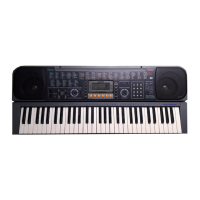
Do you have a question about the Casio CTK-601 and is the answer not in the manual?
| Keyboard | 61 keys |
|---|---|
| Rhythms | 100 rhythms |
| Display | LCD |
| MIDI | Yes |
| Power Supply | 9V DC |
| Effects | Reverb |
Welcomes new CASIO electronic musical instrument owners.
Lists symptoms indicating low battery power and the need for replacement.
Details FCC rules for device operation and measures to mitigate radio frequency interference.
Highlights features like 200 tones, 100 rhythms, Auto Accompaniment, and display capabilities.
Explains the meaning of WARNING and CAUTION symbols used in the manual.
Provides essential safety advice for using the AC adaptor and batteries.
Advises on avoiding heat, humidity, direct sunlight, and TV/radio interference.
Instructions for cleaning the keyboard and precautions for the LCD screen.
Warns against climbing on the instrument or stand and provides advice for assembling the optional stand.
Identifies and describes the main buttons and controls on the keyboard.
Explains the information shown on the keyboard's LCD screen and its indicators.
Instructions on how to start, stop, and skip demo tunes.
Describes how to connect headphones, audio equipment, and amplifiers.
Explains battery and AC adaptor usage, including Auto Power Off functionality.
Details how settings and memory are retained and procedures for resetting the keyboard.
Instructions on turning on the keyboard, adjusting volume, and selecting tones.
Explains how to use the pitch bend feature and the different reverb effects.
Guides on playing drum pads and an overview of available drum sets.
Guides on choosing and starting/stopping rhythm patterns.
Explains how to adjust the tempo of rhythms and auto-accompaniment.
Details how to activate and use Auto Accompaniment with different chord fingering methods.
Explains the CASIO CHORD and FINGERED chord input methods with examples.
Describes the FULL RANGE CHORD method for playing chords across the entire keyboard.
Instructions on inserting intro patterns to start rhythms smoothly.
Explains how to use fill-in patterns and rhythm variations for dynamic performances.
Guides on using synchro start for timing and ending patterns for a smooth conclusion.
Details the Free Session feature and how to adjust accompaniment volume.
Instructions on deleting parts from the auto-accompaniment.
Explains the mixer's purpose and lists default channel assignments.
Details how to use Channel Edit Mode to manage channels (on/off/solo).
Guides on adjusting settings like tone, volume, and pan for selected channels.
Describes parameters like Program Change, Volume, Pan, Fine Tune, Coarse Tune, and Expression.
Introduces Synthesizer Mode for creating original tones and its core functions.
Details the four main parameter groups used in Synthesizer Mode for tone creation.
Explains the difference between single and layered tone structures.
Step-by-step guide to creating a user tone by selecting and editing parameters.
Instructions on assigning names and saving custom tones to memory.
Detailed explanation of each parameter and its setting range for tone creation.
Provides helpful hints for creating user tones, including preset selection and parameter prioritization.
Introduces the memory function, track selection, and basic operations.
Step-by-step instructions for recording music in real-time.
Explains how to play back recorded songs from memory.
Guides on recording to multiple tracks using the real-time method.
Provides instructions for step recording to multiple tracks.
Details recorded track data and the meaning of level meter indicators.
Detailed steps for recording chords and melody using step recording.
Explains chord input methods and how to specify note lengths during step recording.
Covers variations for step recording, including intro patterns and chord accompaniment.
Guides on moving the input point to correct mistakes made during step recording.
Explains how to recall and edit individual notes and parameter settings in memory.
Instructions for editing key pressure, pitch, chords, tone numbers, rhythm numbers, controllers, and drum pads.
Guides on deleting individual data items or entire tracks from memory.
Explains how to layer two tones to play simultaneously with a single key.
Guides on splitting the keyboard to play different tones with the left and right hands.
Details how to use both layering and splitting for complex keyboard setups.
Instructions on splitting the keyboard and then layering tones for advanced sound combinations.
Explains how to enable touch response and transpose the keyboard's key.
Guides on using the tuning feature to fine-tune the keyboard's pitch.
Defines MIDI, explains connections, channels, and General MIDI standards.
Details various MIDI messages like Note On/Off, Program Change, Pitch Bend, Control Change, and System Exclusive.
Explains how to access and change MIDI parameters by selecting parameter groups.
Details parameters in Group 1, including GM Mode, Keyboard Channel, and Local Control.
Details parameters in Group 2, including Pitch Bend Range and Assignable Jack Terminal.
Addresses problems like no sound, low volume, and issues related to battery power.
Covers issues with auto-accompaniment not sounding and recording problems.
Addresses problems related to MIDI data playback and unnatural sounds when connected to a computer.
Lists details about keys, polyphony, tones, rhythms, and auto-accompaniment features.
Details specifications for memory function, synthesizer parameters, and mixer channels.
Outlines MIDI functions, terminal types, power supply details, output, dimensions, and weight.
